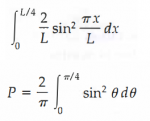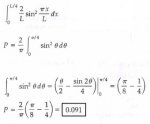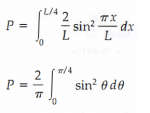When integrating
\(\displaystyle \int_{0}^{\frac{L}{4}}sin^2(\pi \frac{x}{L}) dx\)
And making the variable substitution \(\displaystyle \theta=\pi \frac{x}{L}\) we get the integral
\(\displaystyle \int_{0}^{\frac{\pi}{4}}sin^2(\theta) d\theta\)
But I don't understand why \(\displaystyle \frac{L}{4}\) becomes \(\displaystyle \frac{\pi}{4}\) ?
\(\displaystyle \int_{0}^{\frac{L}{4}}sin^2(\pi \frac{x}{L}) dx\)
And making the variable substitution \(\displaystyle \theta=\pi \frac{x}{L}\) we get the integral
\(\displaystyle \int_{0}^{\frac{\pi}{4}}sin^2(\theta) d\theta\)
But I don't understand why \(\displaystyle \frac{L}{4}\) becomes \(\displaystyle \frac{\pi}{4}\) ?



